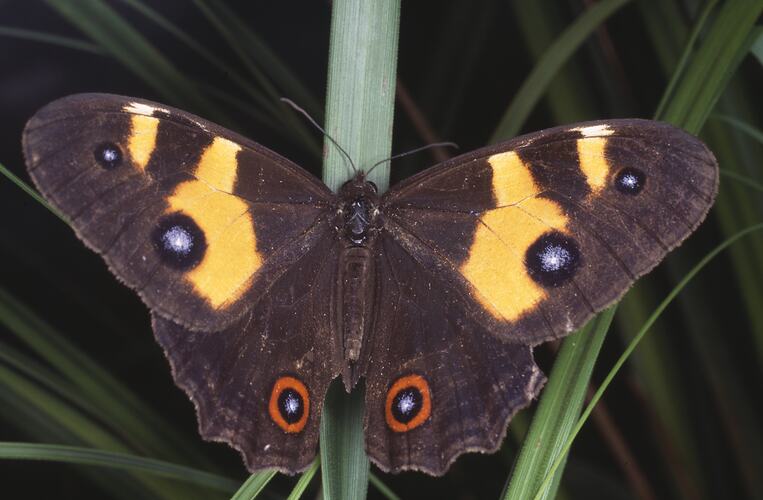General Description
Adult: Above: dark brown, forewing with orange bands and two blue-centred black eyespots; hind wing with a large blue-centred black eyespot ringed orange. Beneath: Brown, forewing as above but paler; hindwing, markings as above but eyespots more prominent in a narrow cream band. Wingspan 54-59 mm. Egg: Green, almost spherical, slightly roughened surface. 1.5 mm. Larva: Green with forked posterior projection. 62 mm. Pupa: Green, and smooth, yellow ridge along forewing. 18 mm.
Biology
Varied Sword-grass Browns are slow, graceful flyers, flying within a metre to the ground and close to their food plants. Adults will frequently land on Saw-sedges to bask in the sun with their wings open. Eggs are generally laid singly on the underside of young leaves. Larvae generally feed on Red-fruited Saw-sedge (Gahnia sieberiana) in Victoria but other Gahnia species have also been recorded as hosts outside Victoria. Larvae shelter near the base of the leaf during the day and ascend to feed at night, creating characteristic V-notches in the leaf. Pupation occurs deep within the plant, the pupa attached to the underside of the leaf and suspended head downwards. In Victoria there is one generation a year at high altitudes, but two generations in warmer areas.
Distribution
Six subspecies are recognised ranging from coastal South East Queensland to the south east corner of South Australia. One subspecies occurs in Victoria from Alpine areas, in the outer eastern suburbs of Melbourne, the Dandenong ranges and wet forest areas of the Grampians, Wilson's promontory and East Gippsland.
Habitat
Common in a range of habitats from alpine to suburban, including wet forests.
More Information
-
Animal Type
-
Animal SubType
-
Colours
Brown, Orange
-
Maximum Size
59 mm
-
Diet
Nectar
-
Endemicity
-
Commercial
No
-
Conservation Statuses
CITES: Not listed, FFG Threatened List: Not listed, DSE Advisory List: Not listed, IUCN Red List: Not listed
-
Plants
Saw-sedges
-
Taxon Name
-
Scientific Author
Waterhouse, 1904
-
Common Name
Varied Sword-grass Brown
-
Other Names
Swordgrass brown butterfly , Large Wood Brown
-
Kingdom
-
Phylum
-
Subphylum
-
Class
-
Subclass
-
Superorder
-
Order
-
Suborder
-
Superfamily
-
Family
-
Subfamily
-
Genus
-
Species Name
abeona
-
Subspecies
albifascia







